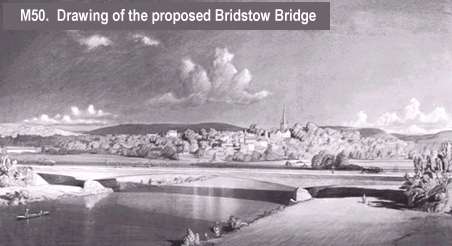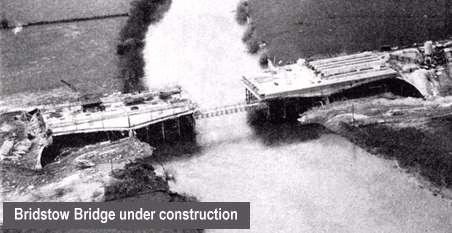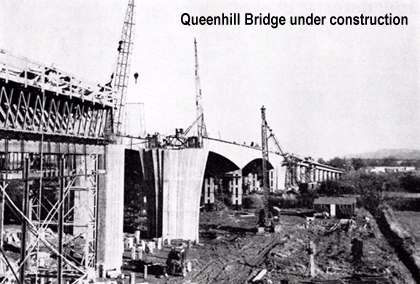History
The M50 was one of the earliest Motorways to be built in the United Kingdom and was started in March 1958 while the Preston-By-Pass was still under construction. Thus it was very much an experimental contract in every way and this should have been reflected in the way it was handled.
Over the years many informed road builders questioned the priority for the early construction of this route before many others of more strategic importance. The concept of this route came from the desire of a labour Government through its Minister of Transport, Mr Barnes, to provide a road of strategic importance linking South Wales to the industrial heartland of the Midlands. The Ross Spur, with the Heads of the Valley route, would give a direct route for the expanding steelworks and coal fields of South Wales to car and engineering factories of Birmingham with the M50 being linked to the M5 North.
The Labour Government was succeeded by the Conservatives in 1951 and because of post war financial crisis and the devaluation of sterling no significant inter-urban road building took place until the late 1950's. In retrospect it would have made economic sense to have built the M5 and Severn Bridge with access into Wales rather than the Ross Spur.
However, with the very severe continuing financial restraints of Government Funds the cheapest short term option of a route to Wales was the construction of the Ross Spur. Also the plans for the M50 were on the drawing boards and well advanced thus enabling the work to be put in hand fairly quickly.
It is noteworthy that the M1 (London-Yorkshire) Motorway, which started at the same time as the M50, was completed and opened to traffic 12 months earlier. Since the M50 is only 22 miles long, and the M1 67 miles long, one has to consider why this happened.
The surfacing for both Motorways was similar (except for the St. Albans section of the M1 - which was Britains first concrete Motorway) - so the bases and sub-bases must have held the clue to the different rates of construction. At the request of the Ministry of Transport there were 5 different specifications on the M50 for the bases and sub-bases. The contractors had a choice, this was naturally the cheapest, but not necessarily the best. This will be mentioned in some detail later.
On March 3rd 1958 an Inauguration Ceremony took place in Herefordshire, when the Minister of transport & Civil Aviation, the Rt. Hon. Harold Watkinson P.C., M.P., lifted a pistol into the air and fired a starting flare. Tarmac's (now Carrilion Construction) tractor drawn scrapers, which had been lined up, began to move, but not as quickly as the Minister and the dignitaries running to avoid the blazing debris.
The M50 Motorway is approximately 22 miles long and was built to the Motorway Standards of 1958. Most staggering was the fact that it only cost some £6,000,000. It was the cheapest Motorway ever built given that it included 39 bridges of which two are major structures.
It is a dual two-lane motorway, having 24ft carriageways, with four 12" marginal strips and, so called, Hard Shoulders 8ft wide. The surface is Hot Rolled Asphalt. It was said to be one of the most scenic and beautiful roads in Britain, and those who have driven along it would hardly be inclined to deny this.
The original length of M50 is located between the A38 near Tewkesbury and the A449 near Ross. The Ross-By-Pass is an all-purpose road 1½ miles long linking the M50 Motorway to the A40. There are two grade-separated interchanges where the Motorway intersects the A417 at Bury Court and the B4221 at Jays Green respectively.
The two major bridges are the Queenhill Bridge over the River Severn and the Bridstow Bridge over the River Wye.
When the M5 was constructed, 1960-1962, Ross Spur was extended from the A38 junction at the eastern end to join the M5 at Strensham. A distance of 1.5 miles. A further grade-separated junction was also built at the A38 Brockeridge Common.
Contract 1
The Ross Spur Motorway & Ross By-PassContract No. 1 covered the Ross-By-Pass and the most South Western section of 5½ miles of the M50, including Bridstow Bridge and Jays Green Interchange. The contractors were Tarmac Civil Engineering Ltd (now Carrilion Construction).

The roadworks were designed and supervised by Herefordshire County Council and the Bridstow Bridge over the Wye was designed by Scott Wilson, Kirkpatrick & Partners.
The carriageway construction comprised a sub-base of 0 - 10" (depending on CBR values) of Crushed Stone, on which was laid a base of two 4" layers of 'Cem-Mix'. In inclement weather it was difficult to blind and compact dry stone bases. The 'Cem-Mix' (a lean-mix concrete with 2½% cement) was pre-mixed at the quarry in a Laings continuous mixer, and was a very controlled and good base.

Having in mind the low cost of this road, it is sad to relate that differences of interpretation arose early on about what payment should be made for dealing with trees and stumps. The north eastern end of the M50 ran through Dymock Forest. The bills of quantities covered the removal of some 20,000 trees, and probably about 20 tree stumps. It would seem that the owners of the timber cleared the site, and by the time the contract was put out to tender, the numbers were reversed. Since a contractors objective is to win the contract, his aim is to have the lowest price at the time of tender, so they had no alternative but to reflect the error in their pricing. Thus a dispute and claim arose very early in the contract since the 'Engineer' did not appear to know how tenders are priced and refused to honour the priced items. Since the claim was probably only in the order of £30,000, and since the works had been so keenly priced, this was unfortunate.
It is even more strange since there was an ambiguity in the specification that referred to the measurement of stumps being based on a diameter of the tree at 2ft above ground level. Naturally most trees are cut nearer the ground than this.
Quite often differences of opinion arose with the farmers, sometimes including the brandishing of shot guns. If the District Valuers had been a little more generous in their valuations, and if the Ministry had paid a little more promptly, this might have been avoided. (Relationships with the farmers improved after the Project Manger had visited them, armed with a wallet full of notes as consideration for land to be used for top soil storage and tips).
In rock cuttings in open country a combination of blasting and ripping with a D9 tractor was adopted. This led to formation difficulties - if over-drilling occurred it produced hollows below formation and if drilling was to formation level, high spots occurred between drill holes. In rock cuttings adjacent to existing housing a careful structural survey was made before and after, but excavation was restricted to ripping and loading by shovel.
In rock cuttings the slopes were 1:4 which left very little room at the toe of the batter for drainage trenches, so little in fact that these had to be dug by hand.
At the very start of the contract, Site Engineers from Contract 1 and 2 met at what was deemed their respective boundaries and found there was a substantial difference. This was about 8ft in line, but since construction work had not started, an accommodation was soon reached.
On another occasion the contractors Site Engineer (now a very respected Consultant in Private Practice) met a rather difficult situation concerning bridge levels which reflected rather badly on his opposite number working for the County Council. Apparently it was resolved to mutual satisfaction by adjusting a Temporary Bench Mark by 1½".
This contract was very keenly priced, as were the others - (as low as £110,000 per mile on Contract 3). On Contract 1, even when claims of £150,000 were paid, the contract still made a loss of over 9%.
Contract 2
This contract was 6½ miles in length, all in the County of Gloucestershire. The road works were all designed by the County Council staff, but the bridges were by W.S. Atkins & Partners.
The geometric details for all the contracts were standard but again the contractor had to choose from several sub-bases and bases that were specified at the request of the Ministry of Transport. The contractors were R.M.Douglas and the Project Manager was Walter Eyre who later joined Freeman Fox and was responsible for many miles of the M5 Motorway in the south west. Walter Eyre refers to the fact that success in winning the contracts was very prestigious, and that this probably made the pricing so keen.
The contractors for Contracts 1 & 2 (Tarmac now Carrilion Construction) & Douglas) had great experience in building pavements for Airfields, but on Motorways the problems of limited access and proceeding on a very narrow front were an entirely different matter.
The Ross Spur contracts had alternative specifications and naturally the contractors priced what they considered were the cheapest. In the case of Contract 2 it was 5" as-dig sand, 5" as-dug sand (later changed to as-dug gravel, 3" of dry-stone macadam (2" single sized stone with 3/4" single sized stone and dust vibrated in) 3" of 1½" single course bitumen macadam topped with 3/4" cold asphalt (later changed to 1½"HRA). A total thickness of 16½". By later motorway standards this was minimal, but it was satisfactory probably due to the lower level of traffic that this motorway generated.
Contract 3
This involved a 6 mile length of motorway in the County of Worcestershire. R.M. Douglas were the contractors and the cheapest form of construction was expected to be the cement stabilised marls, but with all the inherent problems this was probably not so, and eventually involved a seven month delay and a change in the specification that was more practical. The total thickness of the original specification was 14" which must be minimal for the level of traffic that motorways generate.
The contract period was 24 months but this was extended, and did not effect the overall opening of the whole Motorway, since Contract No. 4 (for 2½ years) did not start as early as was originally planned.
It can be concluded that since contractors plant is so expensive, and since Motorways are so plant-intensive, time is of the essence. Therefore variable materials, (and particularly those that are weather susceptible) are not appropriate for fast track work. Although the bases and sub-bases on all the M50 contracts have performed satisfactorily they do not offer the correct solution. Contractors having had experience of them might well tend to 'price them out' if they were specified, since they are not necessarily the cheapest when on allows for all the overhead costs involved.
Contract 4
Contract 4 was only 3 miles long but it included the major Queenhill Bridge crossing the River Severn and its flood plain. Worcestershire County Council was responsible for the design and supervision of the road works and all the bridges except Queenhill. This was designed by Sir Alexander Gibb and Partners and the contractors were A.E.Farr. The sub-base for this contract was crushed stone similar to that for Contract No. 1.

Contract M50 Brokeridge Common to Stensham
This 1½ mile final section of the M50 was commenced in April 1960 and opened in July 1962, some 21 months after the opening of Contract 1 to 4. It was built by Arthur Monk as part of their M5 Contract Lydiate Ash to Strensham.
The construction was similar to that of the M5 and had a sub-base of 6", 12" and 18" of Type 1 material depending on CBR values of the formation. The base was 8" of CBGB surfaced with 2½" Asphalt base course and 1½" of high stone content Wearing Course.
It is worth noting that this is a far more substantial construction than that used on the rest of the M50 just two years earlier.
Finally
The charm of this Motorway lies in its design of line and level, for which great credit is due to the County Surveyors and their staff who planned the road and its many bridges. The bridges have a pleasing variety of colour and design. Cotswold Stone was used for the facings at the Northern end of the contract in Worcestershire, and Red Sandstone for those at the Southern Herefordshire section.
The Dymock Woods were famous for their wild daffodils. Then the top soil from this area was replaced on the central reserve and batters there was a wonderful array of daffodils, and understandably it is considered by many to be one of the most attractive Motorways ever built. When it was opened the motoring public were not aware of the restrictions on its use, and some stopped to pick the flowers. (On one occasion a party set up their pinic table in the central reserve).



